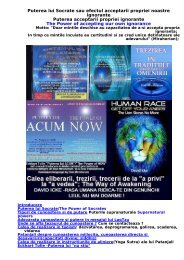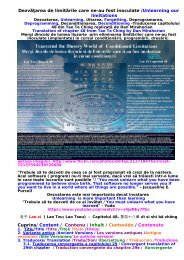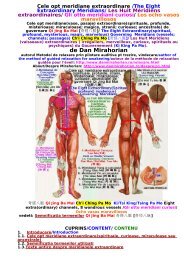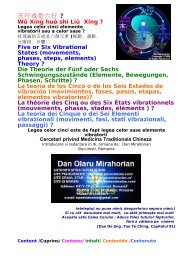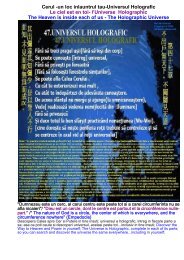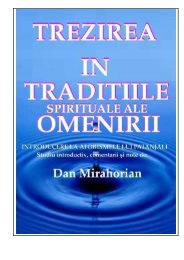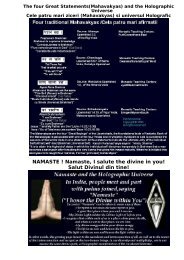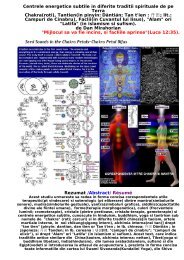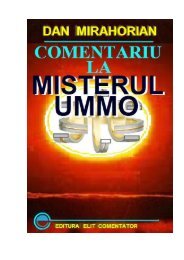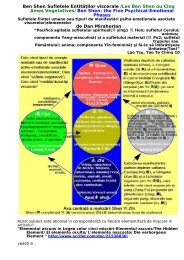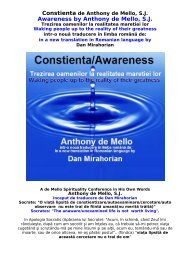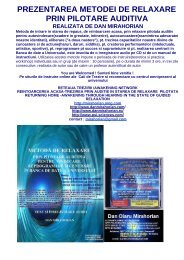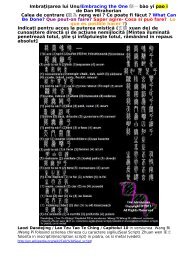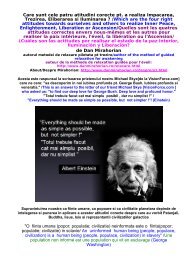Udana Vayu: localizare :gat si cap; centru ... - Dan Mirahorian
Udana Vayu: localizare :gat si cap; centru ... - Dan Mirahorian
Udana Vayu: localizare :gat si cap; centru ... - Dan Mirahorian
Create successful ePaper yourself
Turn your PDF publications into a flip-book with our unique Google optimized e-Paper software.
1.the gross body(sthula sharira) ;<br />
2. the subtle or astral body(sukshma sharira), and<br />
3.the causal body(karana sharira). The karana sharira is called the body of the seed of all<br />
seeds.<br />
The five chief koshas (sheaths).<br />
Clas<strong>si</strong>cally they are the<br />
1) Annamaya kosha which is translated as the "food" sheath (kosha) and corresponds<br />
roughly to the phy<strong>si</strong>cal body. It is characterized by the most dense and slow vibrational<br />
frequency patterns. It is the realm of the sthula sharira (gross body). This is the realm of the<br />
manifest form body of the Buddha, the nirmanakaya. This body can not exist without contact<br />
with the other sheaths (koshas) or bodies, yet for the most part it remains barely activated in<br />
regards to its highest evolutionary potential. When a human being is fully awakened in this<br />
very life, it is said that they have a fully manifested Buddha body (nirmanakaya).<br />
Annamaya kosha - food - phy<strong>si</strong>cal - the five elements<br />
2) The second sheath is composed of the pranamaya kosha or energy sheath. It<br />
interconnects the annamaya kosha (phy<strong>si</strong>cal body) with the other more subtle sheaths (the<br />
manomaya, vijnanamaya, and anandamaya koshas). It is associated with the suksmah<br />
sharira (subtle body).<br />
Pranamaya kosha - breath - vital - the five pranas<br />
3) Next there is manomaya kosha or mental and emotional sheath which also is included in<br />
the sukshma sharira (subtle body),<br />
Manomaya kosha - impres<strong>si</strong>ons - outer mind - the five kinds of sensory impres<strong>si</strong>ons<br />
4) Next the vijnanamaya kosha or the prajna wisdom sheath of Gno<strong>si</strong>s (transconceptional<br />
and transpersonal knowledge) which also is included in the sukshma sharira (subtle body).<br />
Taken together, the annamaya, pranamaya, and vijnanamaya sheaths comprise the subtle<br />
body (sukshma sharira) which is the vehicle for Buddha's bliss body (sambhogakaya).<br />
Vijnanamaya kosha - ideas - intelligence - directed mental activity<br />
5) The anandamaya kosha (literally the bliss sheath) which is associated with the karana<br />
sharira or causal/seed body. In some systems there is a <strong>si</strong>xth sheath, the Hiranyagarbha<br />
kosha (which here will be discussed as existing as one aspect in<strong>si</strong>de the anandamaya kosha).<br />
This karana sharira corresponds to the vajra body or diamond heart -- the immutable<br />
changeless and indestructible body of the primordial Buddha whose vehicle is the<br />
Dharmakaya.<br />
Anandamaya kosha - experiences - deeper mind - memory, subliminal and<br />
superconscious mind<br />
Kaya: Body or vehicle. A Buddhist system first developed to describe the formless and<br />
timeless realm of the primordial (Adi Buddha) Mind of Infinite Space (the Dharmakaya) in<br />
distinction to the temporal and constructed world of form (Rupakaya). According to the<br />
prajnaparamita (a key sutra of the Mahayana) neither exist separate from each other; i.e.,<br />
relative and absolute truth are inseparable). This also corresponds to the Hindu tantric idea of<br />
Shiva/Shakti where Shiva represents the formless eternal and Shakti represents the power and<br />
manifestation of creation (the world of form). Shiva and Shakti also are inseparable.<br />
Later in Buddhist tantra, the rupakaya was sub-divided into sambhogakaya and the<br />
nirmanakaya. Sambhogakaya literally means the enjoyment or bliss body of the Buddha or<br />
<strong>si</strong>mply the enlightened form body where unhappiness has become conquered. This is the<br />
intermediate (remediation) realm between earth and sky,-- crown (formless sky) and root<br />
chakra where yogic transformation occurs. Even though the phy<strong>si</strong>cal body is subject to decay,<br />
this is the realm where buddha activity can none-the less exist as energetic mediator between<br />
the Dharmakaya (unbounded sky) and the finite differentiated matrix of creation. In some<br />
tantric schools it is called the illusory body, the body of light, and is associated with the astral<br />
realms. Many teachings abound that cultivate this realization in both dream and sleep, as the



